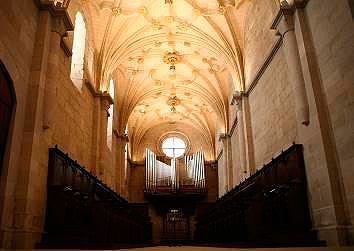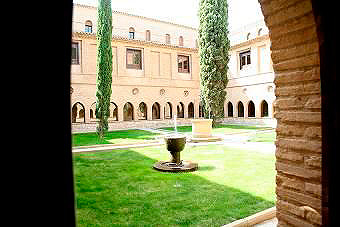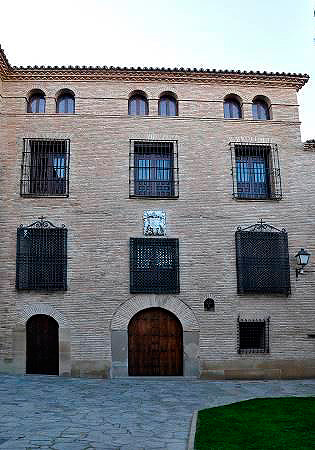19 August
Global Seminars & Invited Speaker Series
HERITAGE AND ENCLOSURE
Nuns who left their mark on the heritage of the Tulebras monastery
Mª Josefa Tarifa Castilla
University of Zaragoza
The nuns who lived in the monastery of Nuestra Señora de la Caridad de Tulebras, the first female foundation of the Cistercian Order in the Hispanic kingdoms, from their establishment in this Navarrese town in 1157 to the present day, have left their mark on the artistic heritage of the monastery, both in the different architectural buildings that make up the monastic complex and through the endowment of important pieces of sculpture, painting and gold and silver work, among others.
Under the rule of the first abbesses who governed the monastery from the middle of the 12th century until the first half of the following century, the construction of the medieval Romanesque monastery of agreementwas undertaken at the usual Cistercian outline, with the abbey church on one side, agreementto which was attached a central cloister around which the rooms of the house necessary for the good developmentof monastic life were articulated, such as the chapter house conference room, the refectory, the kitchen or the dormitory, where the nuns lived humbly and soberly according to the maxim of the Rule of Saint Benedict of "ora et labora". Of that medieval building, only the general appearance of its ground plan and the abbey church has been preserved in the part corresponding to the perimeter walls up to the start of the roof, as well as the Romanesque doorways leading to the interior.
The 16th century was a time of splendor for the monastery from the artistic point of view. The presence in it of nuns belonging to important families from Navarre, whose members succeeded each other in the direction of this abbey, made possible the promotion and endowment of works of art for the monastery. Thus, under the abbacy of Ana de Beaumont (1506-1524), daughter of the lords of Monteagudo, the master builder Francisco el Darocano built a new brick cloister Closed with ribbed vaults in the 1520s. During the rule of the next abbess, María de Beaumont (1524-1547), the reform of the monastery wall was undertaken, which was paid for by her progenitor, Luis III de Beaumont, Count of Lerín and Constable of Navarre. Another prominent member of this Navarrese lineage, Guillaume de Beaumont, Lord of Monteagudo, financed the pictorial altarpiece of San Juan Bautista (c. 1530), an example A of the first manifestations of Renaissance painting in Navarre, which is currently exhibited in one of the rooms of the Museum of Navarre.
Once again, one of the women belonging to the Beaumont lineage took the Tulebrense crosier, María de Beaumont y Navarra (1547-1559), daughter of the IV Count of Lerín, who obtained from the Visitor General of the Cistercians in the crown of Aragon and Navarre, Hernando de Aragón, archbishop of Zaragoza (1539-†1575), the donation of 500 Jaquesan pounds with which he renovated part of the roof of the church, specifically the four sections at the foot with elaborate ribbed vaulting (Fig. 1). The remodelling of the last section of the nave and the chancel was completed during the mandate of the abbess Ana Paquier de Eguaras (1559-1573), who belonged to the lineage of the lords of Barillas, also financed by the Aragonese prelate, work that was carried out between 1563 and 1565 by the Tudelan villa worker Pedro de Verges, who also built a new chapterhouse conference room, the chapel of San Bernardo and the choir loft of the church.

Church of the Cistercian monastery of Tulebras. Photo: Mª Josefa Tarifa.
The Renaissance transformation of the monastic complex did not only affect the architectural part, as the church was decorated with an excellent Renaissance altarpiece dedicated to the Dormition of the Virgin (1565-1570), by the Aragonese painter Jerónimo Vicente Vallejo Cosida, which covered the chancel behind the altar until the last century, and of which the panel of the Trifacial Trinity also formed part initially.
Throughout the centuries of the Baroque, the nuns promoted the reformation and Buildingof new rooms, with the aim of making the monastery more habitable and comfortable, such as the Buildingof the over cloister at the beginning of the 17th century, under the direction of the master builders Pascual de Horaa and Jerónimo de Baquedano, in which the individual cells of the nuns were arranged.

Cloister of the Cistercian monastery of Tulebras. Photo: Mª Josefa Tarifa.
In the mid-18th century, the abbey palace was also renovated under the mandate of Ana Humbelina Arenzana y Oñate and Juana Isabel de Albear, as well as the guest house and other spaces such as the chapel of San Bernardo, which was covered with a dome with a lantern decorated with profuse plasterwork, in accordance with Baroque tastes.

Abbey palace of the Cistercian monastery of Tulebras. Photo: Mª Josefa Tarifa.
During these centuries, the nuns and their families continued to endow the monastery with outstanding sculptural and pictorial pieces, such as the canvas of the Virgin and Child with the Corporals of Daroca, donated in 1617 by the nun Isabel del Bayo, the altarpiece of the Virgin and Child comforting Saint Bernard, paid for in 1649 by the nun Catalina Royo, or the altarpiece of Our Lady of the Rosary, from the mid-17th century, donated by the family of the nun Ana Leonor de Oñate y Barea. But without a doubt, the Marian image of greatest devotion for the nuns and the town of Tulebras was, and still is, the Virgen de la Cama, a life-size sculptural dress piece from the early 17th century, for which a rococo wooden bed was acquired in 1784, together with six blandones, which since 1892 has been adorned with the dress that the nuns embroidered in gold on white satin, thanks to the munificence of their relatives. The nuns also commissioned pieces of gold and silver work for the service of divine worship, including the two silver lamps made in 1613 by the Tuledano silversmith Felipe Terrén, commissioned by the abbess Leonor de Gante and the nun María Jordán, respectively, and the Baroque silver Eucharistic chest made in 1684 in Alfaro by the silversmith Bernardo Peña, which was financed by the whole community with the aim of guarding the Blessed Sacrament in the Holy Thursday monument, as has continued to be the case until a few years ago.
The nuns who lived in the monastery in the 20th century also left their mark on the heritage of the Tulebrense monastery. Given the state of deterioration in which much of the monastic complex was found, in the 1970s they began a profound reform of the monastery, in accordance with the Cistercian aesthetic, under the direction of the abbess Isabel Íñigo Berisa (1963-1975), work which was completed three decades later, in 1996, under the abbacy of Margarita Barra (1982-2007). In order to make the works of art treasured by the monastery accessible to the public, a museum was created to exhibit the sculptures, paintings and gold and silver work, among others, that the nuns and their families donated over the centuries, leaving their mark on the heritage of the Tulebrense monastery.

Museum of the Cistercian Monastery of Tulebras. Photo: Mª Josefa Tarifa.
